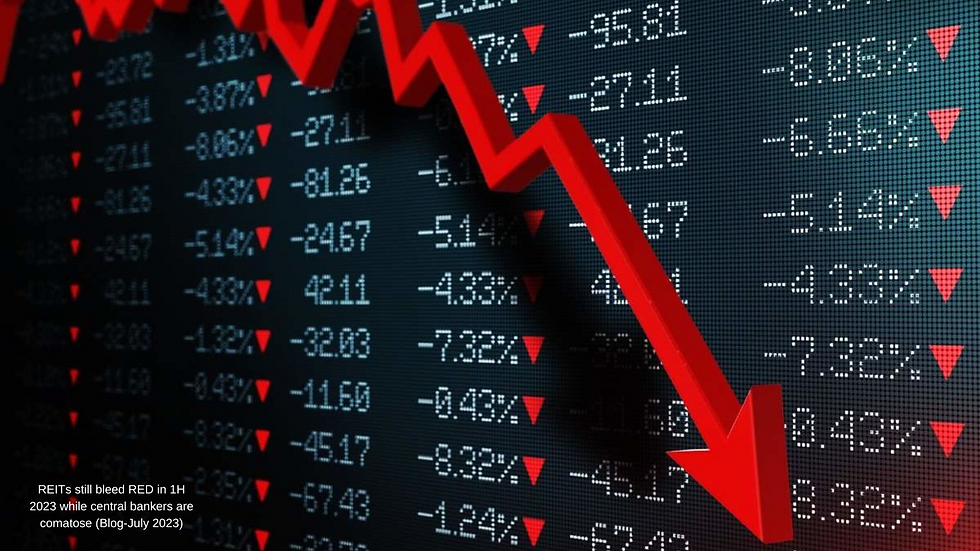PRESCIENT TIMING – WHEN TO SELL YOUR REIT/SHARES? THE SABANA SAGA
- by Gabriel Yap

- Nov 19, 2017
- 4 min read
02/2017-
Just 3 days before the Lunar New Year – the Straits Times reported that a group of Sabana REIT investors have come together to push for a meeting to remove the REIT manager due to “significant price underperformance of the REIT and Sabana's latest move to acquire new properties at questionable prices.

This raised the question of whether the manager acts for the best interest of the unitholders or whether, it acts for the benefit of the sponsor”.
The huge fall in Sabana share price – it is down a whopping 45% to 37 cents from an adjusted (for the 42:100 rights at 25.8 cents) 67 cents in the past year, must have left many Sabana investors wondering why on earth did they not see it coming and why didn’t they hit the SELL button way before that.
A lot of investment classes and books have delved in detail to what and when to buy REITS or stocks, but few highlight the equally important question – what and when to sell what I have. Yet the absence on an exit strategy is an all too common trait, with many investors unsure of when to part company with a REIT or stock before it plunges in price, like the case of Sabana.
Let me use this live example to share.
As at 25th Feb 2016, I was listed as one of the Top 20 shareholders of Sabana Reit with 3.01 million shares (yes I like to buy BIG).
I watch my investments closely and follow up with management, usually over a luncheon meeting, tea or office meeting every quarterly when it comes to REIT to discuss the latest results and review the operations.
At my previous meeting with Mr Kevin Xayaraj, Sabana’s CEO and Ms Grace Chen, Sabana’s Public Relations Officer on Tuesday 11th August 2015 at 3 pm at TWG, ION Orchard, I had highlighted to management a few important facts –
Sabana’s quarterly DPU for the last 6 quarters up to 2Q2015 have been lack-lustre. DPU payout had hovered between 1.78 cents – 1.88 cents. REIT investors need to see steady consistent growth.
The uncertainty revolving the expiry of master leases for its properties – 34 Penjuru Lane, 23 Serangoon North Avenue 5, 15 Jalan Kilang Barat and 218 Pandan Loop. As these were master leases properties and well-known in advance, I had advised management to act quickly to either secure a favourable extension of the current master leases arrangements or prepare (if they had not started) for conversion to multi-leases.
Come January 2016, Sabana reported a shocking dismal quarterly 15.3% drop in its 4Q2015 DPU – down to 1.5 cents from 1.77 cents.
The uncertainly of its master lease expiries had continued to undertake their toils. To me, it was clear that fundamentals have deteriorated, a key reason for investors to SELL their REITS/stocks.
Understandably, the selling decision is doubly hard as it forces the investor to face a mix potent of emotions – regret, indecision, fear etc, emotions that people generally would want to avoid.
For me, I look beyond that as if indeed fundamentals have deteriorated (yes management can blame the weak industrial market condition), they are clear signs for me to divest especially since the key questions of falling DPU and master leases which were highlighted in my quarterly meetings with management, were confirmed. Yes, as investors, we look for confirmation of fundamental signs, good or negative, to base our SELL decisions. No iota of emotion or guilt should be allowed to assimilate into this systematic decision-making process (which I teach in my various investment class).
Also, most SELL decisions actually involve 2 choices - when to sell and what to reinvest in with the funds raised.
For me, the push factor was easy as I was eyeing Dairy Farm which fell below US$6 in March/April 2016, collapsing from a high of US$13.70 from 3 years ago. Taking advantage of a technical bounce in Sabana share price in April 2016, I offloaded all my 3.01 million shares and reinvested into Dairy Farm (my analysis have shown that Dairy Farm had probably reached the sharpest discount compared to Sheng Siong at below US$6).
On hindsight, my 3 years dividend yield of 9% pa from Sabana plus my selling at the peak before the plunge meant that I broke even on Sabana. However, it has not prevented me from riding with Dairy Farm which has risen up to US$8.36 on 2nd Feb 2016 (when this article was submitted).
REIT investors normally invest in a REIT for income. Thus, before you buy it, you must already know when you should sell it. For me, in my 30+ years of investment experience, some of the reasons would be when the REITS suffer a drop in its DPU which clearly indicated a deterioration of its fundamentals.
To catch the early warnings signs of deterioration are as important as when to buy your stocks. I teach such skills in my investment classes and the next class would be on 11 March 2017 – you can sign up at https://eventbrite.com/e/tactical-profitable-positioning-in-reits-preparing-for-the-next-market-crisis-tickets-30773351924.




Comments